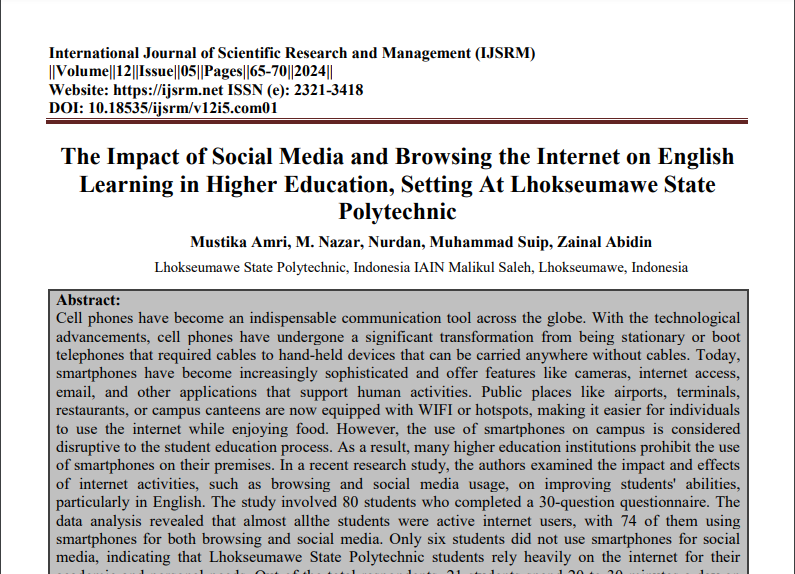The Impact of Social Media and Browsing the Internet on English Learning in Higher Education, Setting At Lhokseumawe State Polytechnic

Submission to VIJ 2024-05-21
Keywords
- Keywords: smartphones, browsing, social media, English
Copyright (c) 2024 Mustika Amri, M. Nazar, Muhammad Suip, Zainal Abidin

This work is licensed under a Creative Commons Attribution 4.0 International License.
Abstract
Cell phones have become an indispensable communication tool across the globe. With the technological advancements, cell phones have undergone a significant transformation from being stationary or boot telephones that required cables to hand-held devices that can be carried anywhere without cables. Today, smartphones have become increasingly sophisticated and offer features like cameras, internet access, email, and other applications that support human activities. Public places like airports, terminals, restaurants, or campus canteens are now equipped with WIFI or hotspots, making it easier for individuals to use the internet while enjoying food. However, the use of smartphones on campus is considered disruptive to the student education process. As a result, many higher education institutions prohibit the use of smartphones on their premises. In a recent research study, the authors examined the impact and effects of internet activities, such as browsing and social media usage, on improving students' abilities, particularly in English. The study involved 80 students who completed a 30-question questionnaire. The data analysis revealed that almost all the students were active internet users, with 74 of them using smartphones for both browsing and social media. Only six students did not use smartphones for social media, indicating that Lhokseumawe State Polytechnic students rely heavily on the internet for their academic and personal needs. Out of the total respondents, 21 students spend 20 to 30 minutes a day on social media, accounting for 26.3 percent of the total. 19 students used smartphones for social media for about 2 to 4 hours. Surprisingly, 11 students were willing to spend more than 5 hours a day on social media. The findings reveal that most students at Lhokseumawe State Polytechnic are more inclined towards social media rather than browsing the internet. The t-test and F-test showed a significant correlation between browsing and social media usage with English achievement among students of Lhokseumawe State Polytechnic. It indicates that using the internet for browsing and social media has a positive impact on academic performance, particularly in English.
References
- Amri, Mustika, M. Nazar, Nurdan Nurdan, Muhammad Suip, and Zainal Abidin. 2023. “The Use of Indirect Language Learning Strategies for The First Language Users at Lhokseumawe State Polytechnic.” Asian Journal of Engineering, Social and Health 2(6):375–85. doi: 10.46799/ajesh.v2i6.66.
- Astivia, Oscar L. Olver., and Bruno D. Zumbo. 2019. “Heteroskedasticity in Multiple Regression Analysis: What It Is, How to Detect It and How to Solve It with Applications in R and SPSS.” Practical Assessment, Research and Evaluation 24(1):1–16.
- Bhushan, Shanti, and Shashi Alok. 2019. “Handbook of Research Methodology.A Compendium for Scholars y Researchers.” Educreation Publishing 9(1):28.
- Esechie, Godswill Ejeohiolei, Chukwuka Christian Ohueri, Siti Zanariah Ahmad Ishak, and Peter Karubi Nwanesi. 2022. “Framework for Enhancing Students’ Smartphone Learning Ability: A Case Study of Nigerian Public Universities.” Journal of Information, Communication and Ethics in Society 20(2):213–28. doi: 10.1108/JICES-04-2020-0049.
- Huang, Shunsen, Xiaoxiong Lai, Xinmei Zhao, Xinran Dai, Yuanwei Yao, Cai Zhang, and Yun Wang. 2022. “Beyond Screen Time: Exploring the Associations between Types of Smartphone Use Content and Adolescents’ Social Relationships.” International Journal of Environmental Research and Public Health 19(15). doi: 10.3390/ijerph19158940.
- Liany, Gladys, Golda J. Tulung, and Theresia M. C. Lasut. 2021. “Persepsi Mahasiswa Terhadap Pengaruh Penggunaan Instagram Dalam Pembelajaran Bahasa Inggris.” Jurnal Elektronik Fakultas Sastra 18:1–20.
- Matsumoto, Yumi. 2021. “Student Self-Initiated Use of Smartphones in Multilingual Writing Classrooms: Making Learner Agency and Multiple Involvements Visible.” Modern Language Journal 105(c):142–74. doi: 10.1111/modl.12688
- Selwyn, Neil, and Jesper Aagaard. 2021. “Banning Mobile Phones from Classrooms—An Opportunity to Advance Understandings of Technology Addiction, Distraction and Cyberbullying.” British Journal of Educational Technology 52(1):8–19. doi: 10.1111/bjet.12943.
- UĞUR, Naciye Güliz, and Tuğba KOÇ. 2015. “Mobile Phones As Distracting Tools In The Classroom: College Students Perspective.” Alphanumeric Journal 3(2). doi: 10.17093/aj.2015.3.2.5000145549.